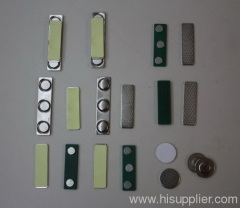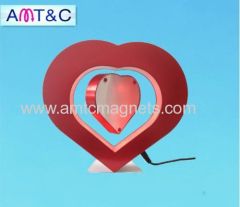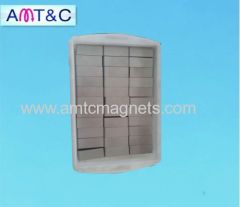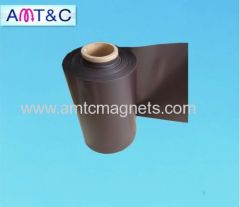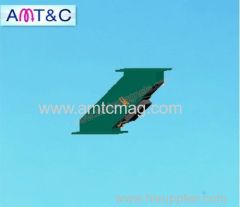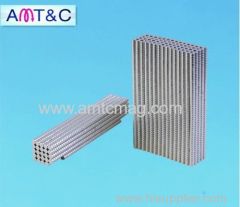
|
AMT&C NINGBO,LLC
|
SmCo magnet of AMT&C
| Price: | 1.0~10.0 USD |
| Payment Terms: | T/T,L/C |
| Place of Origin: | Zhejiang, China (Mainland) |
|
|
|
| Add to My Favorites | |
| HiSupplier Escrow |
Product Detail
Samarium-Cobalt Magnet is ideal for use in devices like servomotors, sensor controls and other equipments
INTRODUCTION:
Samarium Cobalt permanent magnet is widely used second generation high energy material. Using Samarium and Cobalt as its rare earth element, it exhibits high magnetic performance characteristics in energy product and coercive force. There are two compositions of magnets in this family: Sm1Co5 and Sm2Co17. The highest commercially available energy products of Sm2Co 17 are in the 30MGOe range.
Samarium Cobalt permanent magnet is widely used second generation high energy material. Using Samarium and Cobalt as its rare earth element, it exhibits high magnetic performance characteristics in energy product and coercive force. There are two compositions of magnets in this family: Sm1Co5 and Sm2Co17. The highest commercially available energy products of Sm2Co 17 are in the 30MGOe range.
Sintered SmComagnet is one of the two types of rare earth magnet, which is made of an alloyof samarium and cobalt. It is the second strongest powerful of magnet, but it has better temperature stability (maximum working temperature is between 250 and 350°C and the curie temperatures is from 700 to 800 °C).
The flux densityof sintered SmCo magnets will vary under 5% per 100°C change in temperature (inthe range of 25–250°C). They are mainly used in the high-end applications whichrequire operating at cryogenic or high temperatures (over 180°C), such aselectric motors, turbo-machinery and traveling-wave tube.
Samarium-Cobalt Magnet owns following advantages:
1. possess strong magnetic properties - 5-7 times more powerful than ferrite
2. very steady in the conditions capable to cause corrosion
3. possess stable magnetic properties at high temperatures (to 350°c)
Manufacturing Methods
Common Applications for Samarium Cobalt Magnets
Samarium-Cobalt Magnet owns following advantages:
1. possess strong magnetic properties - 5-7 times more powerful than ferrite
2. very steady in the conditions capable to cause corrosion
3. possess stable magnetic properties at high temperatures (to 350°c)
Manufacturing Methods
SmCo magnets are manufactured in the following forms:
Sintered - fine SmCo powder is compacted in a die and then sintered, fusing the powder into a solid material. There are two forms of pressing: die pressing (which involves a hard die into which the powder is placed and then pressed), and isostatic pressing (involving a special "rubber" die into which powder is placed and then pressed with equal force in all directions on the powder). Die pressed parts are smaller than isostatically pressed parts. Although the magnetic properties of isostatically pressed parts are higher, the uniformity of magnetic characteristics is usually lower than that of die pressed parts. Sintered parts usually need some finish machining in order to meet final tolerances.
Compression Bonded - this is a technique whereby a special form of SmCo powder is blended with a plastic carrier material, die pressed and then heated. Parts made in this way can be of complex shapes and come off the tool with close tolerances, requiring no further finish machining. They have lower energy products than sintered materials - currently in the range of 15 MGOe.
Holding systems requiring very high holding forces, high field yoke magnets, high performance stepper, DC, servo, linear, and voice coil motors, magnetic bearings, magnetic couplings, loudspeakers, Halbach arrays, headphones, microphones, magnetic separation, instrumentation, switches, relays, magnetic resonance, sputtering, vacuum deposition, charged particle beam guidance, particle accelerators, Undulators, Wigglers, and others.
Didn't find what you're looking for?
Post Buying Lead or contact
HiSupplier Customer Service Center
for help!
Related Search
SmCo Magnet
Smco Permanent Magnet
Smco Rare Earth Magnet
Sintered Smco Magnet
Smco Magnet Block
Smco Magnet Arc
More>>





